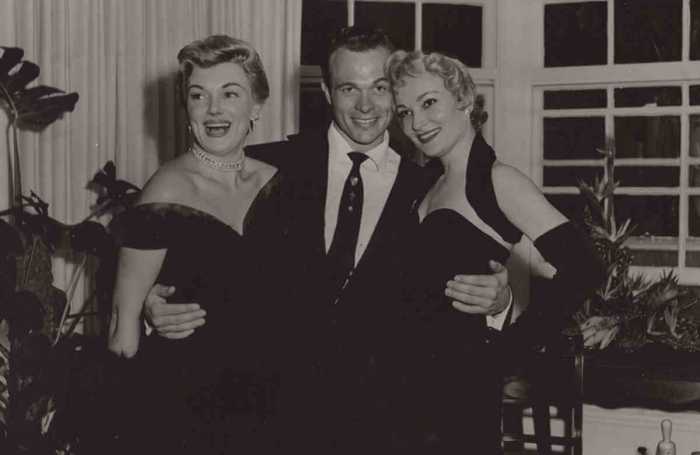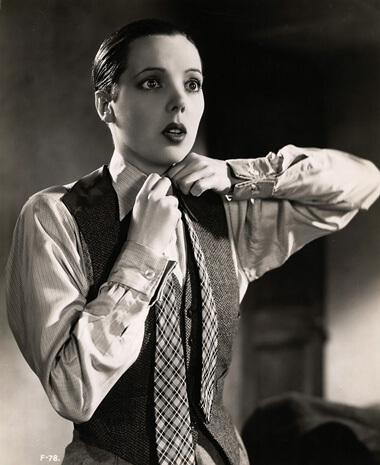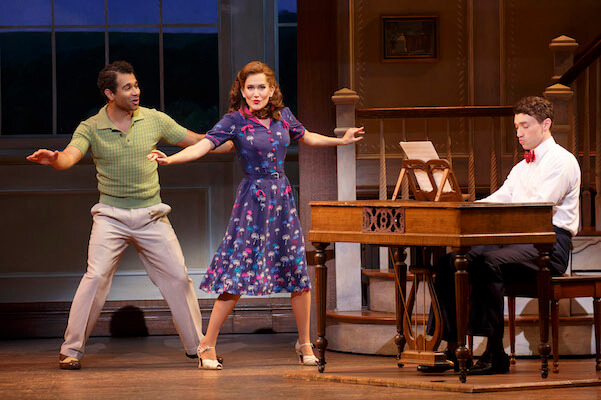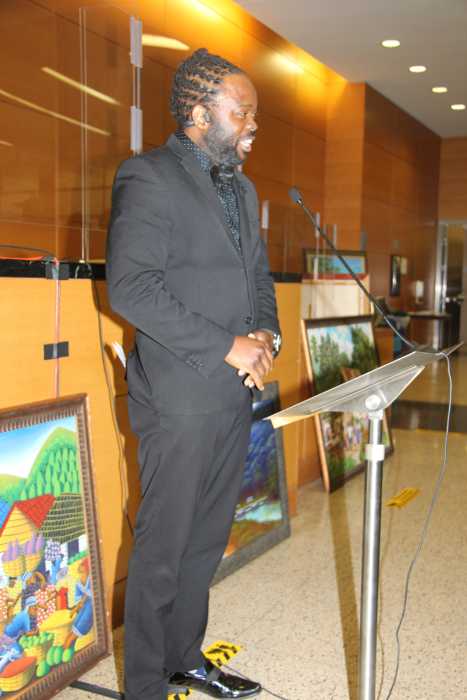Barrie Chase and Fred Astaire.
For those of us forever enraptured by Hollywood’s Golden Age and its indelible personalities, chasing memories is a race against time, as each passing year sees fewer and fewer of them alive and well enough to tell their tales.
Dancer Barrie Chase, one of the last studio contractees during the sunset of musical productions as regular audience fare, at 82 but looking far younger, brims over with the kind of juicy, juicy lore in the possession of only those who truly lived through it all. Big stardom may have eluded her, but she is forever enshrined as the last major dancing partner of the immortal Fred Astaire, having been discovered by him and hired to appear as his co-star in four memorable TV specials.
Chase showed up in the Randolph Restaurant of the Warwick Hotel dressed California rock chick style, in a slinky black T-shirt and miniskirt, and proved a complete knock-out, both physically and with her effervescent personality. She’s as brutally honest as anyone I’ve ever met and deliciously down to earth, as most dancers tend to be.
Fred Astaire’s storied final partner offers the full lowdown
I wanted to get the real lowdown on the ultimate perfectionist Astaire who, genius hoofer that he was, from many accounts, was not half the fun he seemed onscreen.
“He was!” Chase averred. “Being a taskmaster can even be fun! Don’t you think that most people who are good at what they do are always self-questioning and there’s always something more you can do or ask of yourself? Most of the truly greats that I have met are that way. It’s like you’re living up to what others are working for and with what they want and expect from you, but it’s really what you want from yourself.
“Fred was like that, but he was never nasty. He only took after me once, during a rehearsal, and I left. I thought it was out of proportion, although he had probably 800 reasons. But most of the time, he just said, ‘Sweetie, can you do it again?’ And again and again. Fine with me: let’s see what we can scrape the barnacles off of to figure it out.”
What about all the recurring rumors that the two of them were personally, as well as professionally, involved?
“Oh, they always say that, so I just let them think what they want to think. I’m tired of that question. People are going to believe what they want to.”
And, as for that other recurring rumor that, surely, the world’s greatest dancer had to have been gay on some level: “I didn’t know about his personal life. Nor did I care what it was. What he was was uniquely wonderful, and at a time when Hollywood was very anti-gay I must say he was very accepting of the gay community, and embracing.
“I always thought what business is it of mine who someone wants to be with.”
Astaire and Chase met on the MGM lot in 1957, when he was making “Silk Stockings” and she was doing “Les Girls,” directed by George Cukor and choreographed by her other great mentor, Jack Cole.
“Jack always rehearsed with piano and live drums. At MGM there were two large rehearsal halls and in between them, like an H, a smaller one for stars who wanted to do things on their own privately. We were in one large hall, and ‘Silk Stockings’ in the other.
“The door would open, and we all noticed. ‘Jesus, it’s Fred Astaire!’ The drumming was what attracted him, also because he was a drummer himself. I’d be there, early in the morning, with the boys, following like a ragamuffin, always a couple of beats behind. Jack would demonstrate, and I had to pick it up. Every once in a while, Jack would come over and correct a body position, but you really had to work to learn it, which in retrospect was really good.
“Fred was sitting with Jack one day, and we were all waiting for Fred to leave so we could start rehearsing. Jack came over and said, ‘There’s a little dance thing in “Silk Stockings” and Fred wants to know if I would let you do that.’
“Ohmigod, Fred Astaire wants me, and I can’t do it. I didn’t say a word, though, and Jack said, ‘I am going to let you do it but you’re going to have to do both jobs and you are not to slough off this one. ‘Oh, thank you! Thank you!’ I stayed late and never got a step wrong, and that’s how that started.”
One definitely gay man Chase encountered during “Silk Stockings” was Sydney Guilaroff, the studio’s revered long-time hair stylist.
Barrie Chase with David Noh.
“I was always a dance rat. You never got your hair done, and mine was always scraggly. Fortunately, Fred liked that look, but he sent me up to makeup and hair. Guilaroff didn’t know what to do with me, so he slicked my hair back and put a chignon on the back of my neck, a classic look that was the fashion at the time.
“Fred took one look at me and said, ‘What have you done? I don’t like it at all.’ He called the director, Rouben Mamoulian, over, who said, ‘Get Guilaroff down here now!’ Ohmigod, they’re about to shoot and Fred told Sydney, ‘Get that thing off the back of her neck! She looks like Veloz and Yolanda [a popular ballroom dancing team of the time]. I want her to look like herself.’
“That was not an easy task because I had been lacquered within an inch of my life. They had to take me out and wash my hair while everyone was waiting on the set. It was glued into place and then they had to dry my hair! That was Ava Gardner’s dress on me in that scene. I had done a lot of modeling for [costume designer] Helen Rose, was always getting out of the chorus to do fun stuff like that. Helen said, ‘I am going to take care of you. You’re gonna have a really good dress!’ She picked out a gold lame dress with Ava’s name on the label. Ohmigod, I got that world beauty’s dress. Helen was always nice. I must say there were very few people in my working life that were not really nice. I was very fortunate.”
The behind-the-scenes people were fine, but when it came to some of the big stars, it was a different story: the competitiveness was brutal and a definite impediment to the stardom which many felt should have come Chase’s way. After a decade or so of mostly small dancing extra parts in big musicals — “Brigadoon,” “Kismet,” “Call Me Madam” — her big break finally seemed to arrive when 20th Century Fox, where she’d signed a longtime contract, announced that they had bought the Broadway musical “Can Can” for Marilyn Monroe, with Chase cast in the other female role.
“So, here’s the real story despite whatever Miss Shirley MacLaine wants to say. I was having dinner with Fred and he said, ‘Although you don’t want Hermes Pan as your choreographer for this, you owe it to him. This is going to be big.’ So, like a good little girl I am, I hired him. Where did it get me?
“We’re in the rehearsal room and he comes in, knowing nothing about the show. We noodle around for months, but nobody’s showing up because there’s no Monroe. Finally, I get a call, ‘We’ve given up on Monroe.’ Instead, they’ve hired Frank Sinatra and made my part into a man for him, and along with him comes Shirley MacLaine.
“It starts to dawn on me that I do not have a dance number, and I am designated to be the snake in an Adam and Eve dance, that’s all. I go to the producer and say, ‘That’s not cutting it. I don’t care if I’m nothing else in the movie but I want just one dance number.’
“Word comes back: ‘Nope. MacLaine is taking all the numbers.’ I wanted to drop out of the picture, but they said, ‘No, no, Barrie Chase is the snake. But Frank will sing a song to you.’ So I say, ‘Which profile? Do I look adoringly at him this way, or that? I love Frank but I need something more than his just singing to me.’”
Chase called syndicated columnist Sidney Skolsky, a family friend who operated from a stool at Schwab’s Pharmacy, and told him the studio was refusing to take her off the picture. He told her, “There’s one way, but I don’t know if you can carry it off. Make rehearsal unpleasant and they’ll get rid of you.”
“It was a challenge but I love that. I had a sudden memory loss and had a really hard time remembering dance combinations. ‘Oh, I’ll get it this time!’ In between, I would sit by myself, until someone came up and said, ‘Miss MacLaine would like you not to show up to rehearsal.’ So I was out.
“But here’s the kicker. Years later, I run into Greg Garrison in New York, who directed one of the Astaire specials, and we went to dinner. All these big shows had opened, and I hadn’t been asked to do any of them. ‘You’re blacklisted,’ he told me. Sinatra had said, ‘Hands off Chase. You don’t touch her.’ Additionally, he was so miffed that I wanted out of having him sing to me, that he said, ‘I’ll take any chorus girl and make her what Fred made of Barrie. Who the hell does she think she is?’”
And to add to this drama, enter Juliet Prowse, who played the third female lead, a model.
“He hit on Juliet, and it was just a fluke that she was very talented and they hit it off. So out went MacLaine and in came Juliet, which was wonderful because it made a career for her. And there she is in ‘Can Can,’ actually sharing the can can number with MacLaine, and all these other opportunities which were not offered to me. I was the snake. Period.”
I told Chase that I was surprised Sinatra didn’t hit on her. “Sinatra was sniffing around me on ‘Pal Joey’ but I didn’t go there. Rita Hayworth on that film was divine, a wonderful person who would sit around with us and talk. Kim Novak treated her terribly. She was the new [Columbia studio head] Harry Cohn girl, and Rita was 40 and showing it a bit, but still gorgeous.
“Kim demanded that Rita’s hair always be up. In all her scenes, her hair is in a chignon, except for her solo, which Hermes Pan choreographed for her. He said, ‘I’m going to make Rita look like Rita and she’s going to be in a bed, looking good, and her hair is going to be down.’
“I don’t know why, but Kim was not a happy camper when they were together, shooting their number. She didn’t come out of her dressing room the whole day, and I thought, ‘This is bloody Rita Hayworth! You don’t treat her like that!’ Rita was great, she never said a word, just clocked in and clocked out. Kim never came out, and it was resumed the next day.”
I told Chase that it is in this shared number between the two divas and Sinatra that Rita also sports her trademark waterfall of red hair.
“Well, there you go! But I do remember Pan telling me about her solo.”
Another frosty diva was Cyd Charisse. MGM producer Joe Pasternak was always asking Chase out and, although she didn’t want to date him, when he said he was cooking goulash at Charisse’s house, she thought she’d like to see her home and accepted his invitation. They got there early and were greeted by Charisse’s husband, singer Tony Martin. He invited her for a drink at the bar when Pasternak went into the kitchen and, when Chase said she didn’t know what she wanted, as she wasn’t a drinker, he offered to open a bottle of champagne.
“In those days, the living room was always divided by a bar and on the other side of the room were couches and chairs. People started coming in, who all knew one another, and all the women sit on the couches, talking, while all the men go to the bar for a drink, and there I am, too scared to move.
“I don’t know what to do, am up in shallow water, when in comes Cyd, the grand entrance, gorgeous looking. She sees this woman with all the men at the bar and all the women over there, and was totally dismissive of me, doesn’t say hello. So I just stay where I am, frozen. In comes Joe, dinner is ready, and he says, “I gotta get up early in the morning, I’ll take you home.’ And he did, always a total gentleman.
“So, the next day, I was having coffee from the wagon by the rehearsal room, and my friend, Pat Dennis, a wonderful dancer and unsung, brilliant assistant to Gene Kelly, says, ‘I understand you were at Cyd’s last night. The way Cyd has it, you came in and completely took over, and ordered a bottle of champagne!’
“In later years, a choreographer who shall remain nameless, working with me on ‘The Hollywood Palace,’ was going to interview for a job with Cyd. I said, ‘You can throw my name up but it might not get a good reception.’ He did, and her comment was, ‘She has wonderful feet.’ [Laughs.] I always said to Fred, ‘She’s a cold, cold lady, but he said, ‘No, she’s shy, shy, shy.’ I think in the very later years he accepted what I said.”
One more MGM lady whose image belied the truth was “wholesome” America’s sweetheart, June Allyson, with whom Chase made “The Opposite Sex.” In that film, during the famous confrontation scene between Allyson and Joan Collins, who played her husband’s mistress, Allyson slaps Collins so hard her earring flies off. “I wouldn’t be surprised. We were all laughing at June the whole time. She was married to Dick Powell, and she had this enormous crush on Jeff Richards, the cowboy in the movie. He was not that interested in her, at all, just going along for the ride, and she would very publicly come and sit on his lap.
“We just thought, ‘You’re still a married woman. Why are you doing this with him?’ And he couldn’t have cared less. During filming, Joanie, who was very kind to me then — ‘Hey, everybody, look at this kid!’ — hung out with me and Carolyn Jones, who was getting married to this unknown writer, Aaron Spelling. However, after she got successful, I ran into Joan in Beverly Hills and went running over like the stupid kid I was. She was very nice, but dismissive, had become ‘Dynasty,’ and I thought, ‘Well…’
“Ann Sheridan was dying during the making of ‘The Opposite Sex,’ came up to me, and she said, ‘You stay with it. You’ve got the cheekbones.’ [Laughs.]”
If nothing else, over the course of our marathon, quite fabulous three-hour dish session, Chase gave me the answer to one of the big Astaire questions.
“He once asked me who my favorite of all his dancing partners was. He laughed when I said Rita. Although he would never say, Rita was his favorite. Years later, he said I was. I said, ‘Why didn’t you say that then, when it could have helped me?’
“He thought Cyd was a wonderful dancer, but Rita had something. There was just a thing about her. Audrey [Hepburn] always wanted to be his favorite, and she wrote him a funny letter after our first Astaire special that he shared with me. It said, ‘Well, of course, she didn’t have to dance on the wet grass with you!,’ referring to the last scene in ‘Funny Face,’ where they got all muddy.”





































